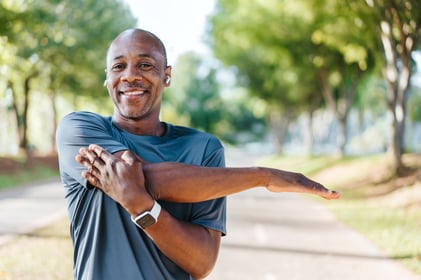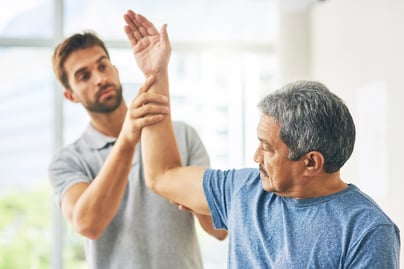 Arthritis is not a sign that you are aging; rather, it is a testament to the vibrant life you have led and all the incredible things your body has accomplished for you! Just imagine the tales your joints could share. Now, it is time to embrace a new narrative for this season of your life, embracing those little creaks. By making simple adjustments to your exercise and wellness regime, you can stay active, strong, mobile, and happy. Here is what you can do to keep your joints healthy as you age.
Arthritis is not a sign that you are aging; rather, it is a testament to the vibrant life you have led and all the incredible things your body has accomplished for you! Just imagine the tales your joints could share. Now, it is time to embrace a new narrative for this season of your life, embracing those little creaks. By making simple adjustments to your exercise and wellness regime, you can stay active, strong, mobile, and happy. Here is what you can do to keep your joints healthy as you age.
Adjust your Workouts
When choosing exercises, it is essential to consider activities that are gentle on the joints but still effective in building strength and flexibility. Here are five arthritis-friendly exercises:
- Walking: A simple yet effective way to keep moving without putting too much strain on your joints.
- Swimming: The buoyancy of water supports your body and reduces the impact on your joints while providing an excellent full-body workout.
- Yoga and Tai Chi: These practices focus on gentle movements, balance, and flexibility, making them ideal for improving joint function and reducing stress.
- Cycling: Whether stationary or on the road, cycling is a low-impact exercise that helps build muscle strength and improves cardiovascular health.
Three Lifestyle Habits to Adopt
- Staying well-hydrated ensures that joint cartilage remains lubricated, which minimizes friction.
- Quality sleep allows your body to recover and rejuvenate.
- Consuming nutrient-rich foods packed with minerals can help alleviate arthritis symptoms, such as flare-ups.
Flare-ups may occur due to changes in temperature or barometric pressure, high-stress situations, alterations in medication, and even weight gain. Understanding what causes flareups can help you manage them better.
Consider Supplements
Research has shown that taking natural supplements can decrease your arthritis symptoms. According to the Harvard School of Medicine, supplements like Glucosamine, Boswellia, Turmeric and White Willow Bark have shown to have beneficial effects on joint pain. Like any medication, it is important to find out if there are any contraindication’s and consult with a trained professional researching any supplement, medication, or surgery alternatives.
Movement is Medicine
Remember, the key to managing arthritis through exercise is consistency. Even tiny amounts of daily activity can lead to significant improvements in joint health and overall quality of life. So, lace up those sneakers, take that first step, and embrace the benefits that movement can bring to your arthritis care plan.


 I call this the "Awakening." Simply put, you are realizing that your body is feeling the wear and tear of life to this point. It’s that realization that at 40 years old, you shouldn't move through life like you're 20. The point at which an individual becomes self-aware of these aches and pains varies from person to person. Some people don’t have substantial damage to their body and can probably make it well past their 20s before being bothered. My experience, like a lot of other athletes I've talked to, is one where we start to feel the damage a bit earlier than expected. It's like a car that is supposed to be driven ten thousand miles a year but is instead driven twenty thousand. The good part of the awakening process is that it is your call to action!
I call this the "Awakening." Simply put, you are realizing that your body is feeling the wear and tear of life to this point. It’s that realization that at 40 years old, you shouldn't move through life like you're 20. The point at which an individual becomes self-aware of these aches and pains varies from person to person. Some people don’t have substantial damage to their body and can probably make it well past their 20s before being bothered. My experience, like a lot of other athletes I've talked to, is one where we start to feel the damage a bit earlier than expected. It's like a car that is supposed to be driven ten thousand miles a year but is instead driven twenty thousand. The good part of the awakening process is that it is your call to action!
 Arthritis is an increasingly common condition that refers to 100 different types of diseases, affects all age groups and affects 1 in 4 adults, equating to 80 million people in the United States. The most common form seen is osteoarthritis or degenerative joint d
Arthritis is an increasingly common condition that refers to 100 different types of diseases, affects all age groups and affects 1 in 4 adults, equating to 80 million people in the United States. The most common form seen is osteoarthritis or degenerative joint d
 Cherry Berry Smoothie
Cherry Berry Smoothie

 If you’ve spent time in a gym, you know “that guy,” the one who doesn’t work his lower body and just focuses on upper body. Lower-body strength training is just as important as upper-body. The largest muscles are located in the lower body. Working larger muscles tends to get your heart rate up higher and burns more calories. More important, the muscles in the lower body are used for everyday movements and help with balance and coordination.
If you’ve spent time in a gym, you know “that guy,” the one who doesn’t work his lower body and just focuses on upper body. Lower-body strength training is just as important as upper-body. The largest muscles are located in the lower body. Working larger muscles tends to get your heart rate up higher and burns more calories. More important, the muscles in the lower body are used for everyday movements and help with balance and coordination. Your joints play an important role in all of life’s activities. They connect bone to bone, which allows your body to move during everything from sports and exercise to everyday functions such as playing with kids, lifting groceries, performing yard work, and even sitting at a desk.
Your joints play an important role in all of life’s activities. They connect bone to bone, which allows your body to move during everything from sports and exercise to everyday functions such as playing with kids, lifting groceries, performing yard work, and even sitting at a desk.